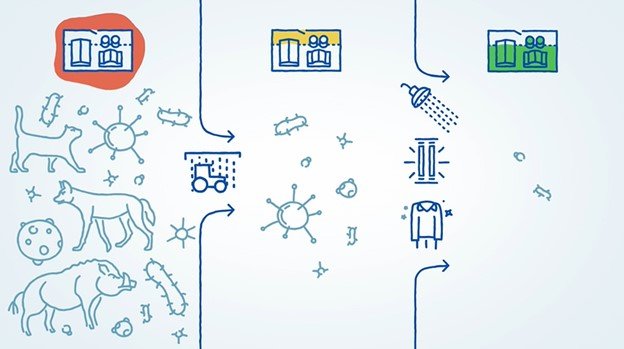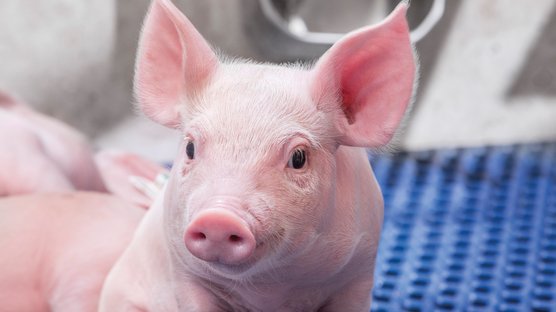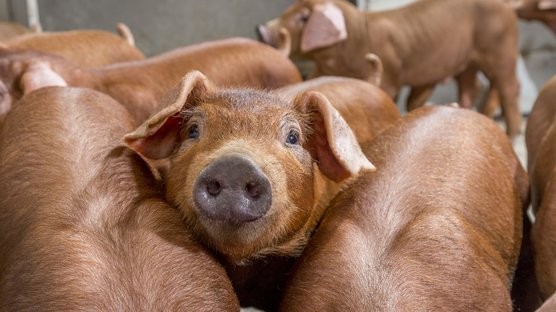
Published on May 23, 2024
Biosecurity: Insights from 30 years of experience in +35 countries worldwide
Does biosecurity need an upgrade? And if so, how?
The principle of biosecurity entered our industry over 50 years ago. The simple procedures that were used at that time allowed the agriculture industry to create a remarkable progress in sanitary statuses of countries, regions, and individual farms. Nevertheless, the incidence of farms breaking down with several aggressive pathogens has been increasing over the last decade.
How do we explain this increase in spreading of disease these numerous sanitary challenges? Why do the measures that worked perfectly before are not having the same positive impact now? In other words: does biosecurity need an upgrade? And if so, how?
Basic principle of disease eradication and prevention of entry of pathogens into a farm (external biosecurity)
The initial basic principle of external biosecurity was based upon the principle of SANITARY ZONES. The most basic version of this principle is reflected in the DIRTY and CLEAN zone principle.
Based on this principle, the average sanitary status of individual farms improved drastically. It even allowed entire countries and regions to eradicate certain pathogens, like FMD, CSF, PED, Brucellosis, PRV, etc. However, when newly emerging pathogens entered our industry, the available biosecurity protocols did not manage to contain these pathogens. Pathogens such as PRRS and PCV2 spread globally in only a few months' time. More recently, the industry is even challenged by pathogens that had been eradicated before!
How do we explain when biosecurity, which proved to be a useful tool in the past, now fails to be as effective in the current challenges? Various factors play a role here.

Biosecurity is being challenged
a) Historical challenges
The main successes in eradication of disease have been realized in the second half of the 20th century. At that time the high quality of scientific research allowed us to create helpful tools for the industry to manage disease. Detailed knowledge of the pathogen itself allowed us to understand the pathogenesis and epidemiology of said pathogen, which then helped to develop regional/national programs to control and eradicate these pathogens. At the same time, efficient vaccines were developed to fight the pathogen and reduce infection pressure.
Also, the initial successes in controlling disease have been reached in a limited number of countries that, at that time, were in the process of adding professionalism to their industry. The connections between these countries were limited at that time. In fact, the disease status in other regions was not that relevant to the professionalized pig industry. Nowadays, the world is totally interconnected, so no matter how low infection pressure is in a certain region, the possible link with areas that face high sanitary challenges will jeopardize sanitation efforts globally.
b) Geographical and cultural challenges
As the porcine industry started to develop on a global scale, we faced several complicating factors:
- Countries with a limited knowledge of the industry increased the number of animals drastically.
- These countries did not and still sometimes do not always develop national or regional programs to control disease.
- The embedded culture for agricultural activity enhanced a strong traditional culture of ‘backyard farming’.
These factors negatively impact the efficiency of industry when reacting to a sanitary threat.
So, over time several factors that helped to stop diseases in the past, are not present anymore or have become less efficient. National control or eradication programs are lacking in various countries, and decent vaccinations are not always available.
As a consequence, as one of the few tools left to fight disease, biosecurity is challenged more than ever!
At the same time, we see that the countries where the industry is more consolidated and experienced also face major challenges. These countries will need to realize that the overall infection pressure towards their production units has been raised, and that as a consequence, the biosecurity measures that were sufficient in the past are not as effective now!
Biosecurity is challenged: Upgrade needed
a) Biosecurity plan:
Biosecurity needs to be part of the business plan for the unit concerned. Location, design, workflow and animal flow need to be reviewed with respect to biosecurity. The major risk factors need to be identified and corrected.
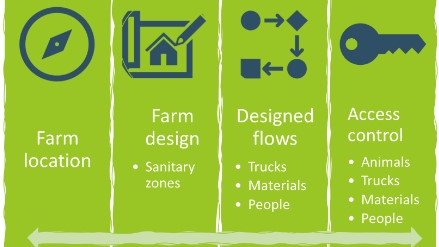
b) Principle of sanitary zones:
The principle of sanitary zones remains the key factor to control disease. However, the basic idea of having a DIRTY/CLEAN zone division is not sufficient anymore.
Do we know of any disinfection procedure that has a 100% result? Other than incineration, 100% effectiveness is impossible to achieve. Logically, it is then also impossible to have 100% disinfected objects entering the CLEAN zone after one disinfection act only! What happens is that we dilute the risk of infection with every disinfection act we take. By repeating disinfection actions in separate sanitary zones, we aim to reduce the risk of infection to zero. Therefore, having only two sanitary zones will always be insufficient. Hypor decided that a minimum of 3 sanitary zones is needed to preserve biosecurity.
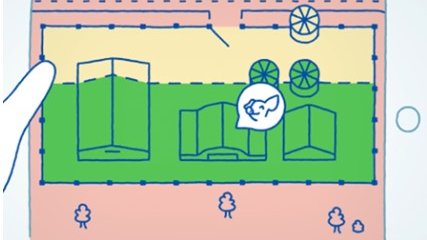
1) Restricted Access Zone (RAZ)
The RAZ of the farm corresponds to the area where the production units or barns are located. This area is controlled by a gate, restricted lane, signage, fence, or a combination of some or all of these items. Only materials belonging to the farm can be inside the RAZ. Pigs inside the RAZ should belong to the farm or have passed quarantine/isolation. The only people allowed inside the RAZ should be the farm staff and allowed visitors (following pig-free downtime requirements) after showering and changing clothes. Transport inside the RAZ should be done using transport belonging to the RAZ and that remains within the RAZ. No external transport should be allowed in the RAZ.
2) Controlled Access Zone (CAZ)
Interaction between the RAZ and the dirty zone which is a part of the farm.
3) Dirty zone
This is any area that is not a part of the farm. This area needs always to be considered as ‘contaminated’. Transport from outside the farm should be only allowed to enter as far as the dirty zone.
Based on the sanitary situation in the area where the unit is located, the numbers of different sanitary zones need to be increased.
c) How to upgrade:
Keep it simple:
The global porcine industry is being challenged by a lack of personnel. This means that we continuously have a high turnover of people on the farms, of which most have very limited experience with pig production, and even less with biosecurity procedures.
We need to react to this by providing our personnel with simple, easy to manage and repeatable protocols.
Hypor biosecurity protocols are limited to a few key topics to control. This strategy prevents us ending up with a multitude of detailed protocols that personnel will not comprehend or that are only useful in theory, but not manageable in practice.
Hypor created a limited number of protocols that are simply to be repeated at the entrance of each sanitary zone:
- PEOPLE: access control for personnel and visitors
- TRANSPORT: entry and exit of animals, semen, feed, dead organic materials, other organic materials, inorganic materials
Given the high turnover of personnel, continuous training is needed. Hypor has also created a series of instructional videos to facilitate the training of inexperienced personnel.
Ask the right question:
Too often we ask ourselves the question ‘How do we make the contact safe’, when the first basic question to ask is ‘do we really need the contact?’. Especially when working with different sanitary zones, it is important to decide what objects need to go into which zone. Too many objects enter the Restricted Access Zone unnecessarily!

Respect the sanitary zones at all times:
As much as the installation of sanitary zones can look perfect in theory, it remains extremely important to check the practical implementation of the different protocols in order to preserve the zones.
The main goal is not to allow any ‘room for interpretation’ when sanitary zones are evaluated. There is no such thing as ‘a slightly dirty zone’ or being a ‘little contaminated’. When having a non-controlled contact with a zone from lower sanitary status, the zone with the higher sanitary status will totally and immediately be downgraded to the lowest sanitary status.
While performing biosecurity-audits, many mistakes can be observed against this principle. The main challenge is often to look for those doors that ‘never’ open!
Do not put too much trust in disinfection:
- Disinfection is only efficient if:
- The correct product is used
- At the correct dosage
- At the correct temperature
- during the appropriate contact time
- In absence of organic material
- How often do we reach this in real life?
We need to be critical to this and not allow objects to enter sanitary zones ‘because they have been disinfected, thus they are safe’!
The main questions always will be:
- Does the object need to enter at all?
- If so, to which sanitary zone does it need to go?
- Do we repeat disinfection actions at each zone?
This theory specifically applies to animal transport. The entire industry is aware that the major risk factor for the spread of disease lies in the transport of animals. Elaborate and specific protocols are designed to create ‘CLEAN’ trucks. Reality shows that we have mastered this technique in that the vast majority of animals that are transported reach their destination with the same health status they started out with. However, this reality also creates a false sense of safety!
Hypor will always prohibit any external truck from making contact with the Restricted Access Zone. The cleanliness of the truck only relates to the inside of the trailer itself. We never have full control of the cabin, or the outside of the truck, let alone the route where the truck is traveling on. This leads to the contradictory statement that ‘a clean truck always remains dirty’ and emphasizes the need to correct (un)loading protocols at farm level.
Is maintaining a high sanitary status still possible?
The current sanitary challenges often need to be faced in the absence of national/regional programs and reliable vaccination or treatment options. At the same time, our industry is struggling constantly to reach the number of personnel needed and to reach profitability by increasing farm size.
Is it still possible to establish a long-term profitable business under these circumstances, without the fear of an unavoidable sanitary crisis that will hit the industry every so many years? By reviewing the biosecurity principles in the way Hypor has been doing over the last decade, and by checking on the correct implementation of it, it has been proven that big production structures can remain free of disease for years.
It all comes down to professionalism inside the industry, connecting the experts in production with experts in biosecurity and having them work out a safe system that is applicable in practice.
The simple conclusion remains that the customers who are best organized in biosecurity will maintain the highest sanitary status over the longest period of time.
